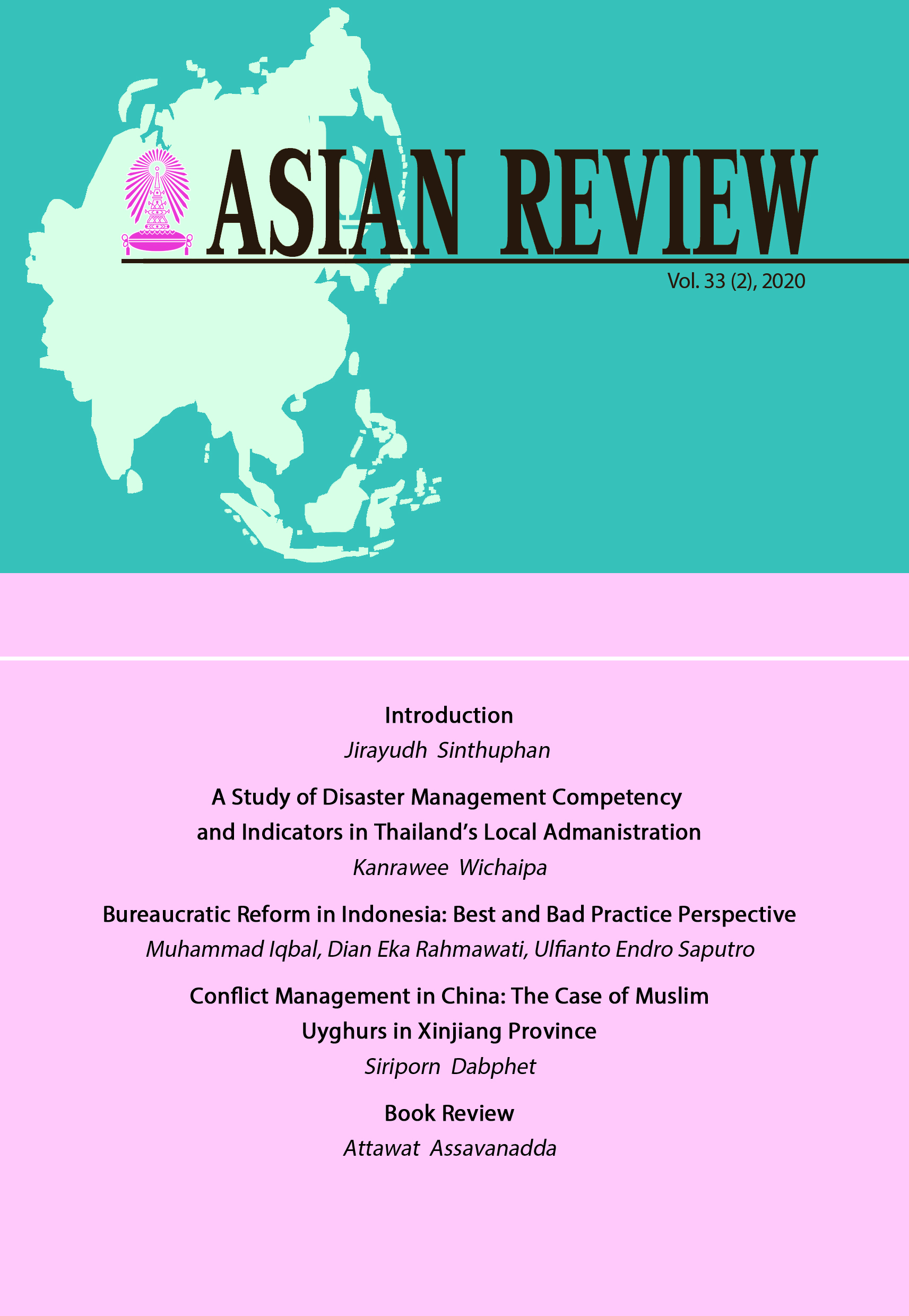Bureaucratic Reform in Indonesia: Best and Bad Practice Perspective
Keywords:
Bureaucaratic Reform, Indonesia, Governance, Best PracticeAbstract
This study is an overview of the process of bureaucratic reform in Indonesia along with examples of best and bad practices in policy implementation. The implementation of policy is essential to the future of Indonesian bureaucracy and governance. The success of bureaucratic reform depends very much on commitment and leadership at both the national and regional levels of government. Without dedication and civic leadership, any implementation of bureaucratic reform is likely to fail as has happened in Indonesia. This research is a descriptive qualitative research. The type of data used in this study is
secondary data obtained from existing literature, resources from various governmental websites, social media, as well as news and documentation.
Towards the end of the second period of bureaucratic reform in Indonesia, it appears that not a single local government had succeeded in applying all the principles of bureaucratic reform. This failure is due to the weakness of Indonesian policymakers in providing support for local government and because of local governments themselves failing to followed the principles of bureaucratic reform.
References
2. Adi, Y. 2019. “Bureaucratic Reform Barriers: A Case Study on the One Stop-Integrated Service Office in Bone Regency.” JKAP Jurnal Kebijakan dan Administrasi Publik 22(2): 146-154
3. Akib, Haedar M., and Andi Ihsan. 2017. “Bureaucratic reform in public service: A case study on the one stop-integrated service.” Mediterranean Journal of Social Sciences 8(2): 253-258
4. Angkasah, Lalu, Huala Adolf, Gatot Dwi Hendro Wibowo and Zainal Asikin. 2017. “Bureaucratic Reform in the Perspective of State Administration Law.” Mediterranean Journal of Social Sciences 8(5-1): 35-41
5. Burke, B. F. 2015. “Bureaucratic Reform.” In Encyclopedia of Public Administration and Public Policy, edited by Domonic A. Bearfield, Melvin J. Dubnick, 1-5. London: Routledge.
6. Dhaliwal, Iqbal, and Rema Hanna. 2017. “The devil is in the details: The successes and limitations of bureaucratic reform in India.” Journal of Development Economics 124: 1-21.
7. Ghosh, Sujata, and Biswajit Mandal. 2019. “Bureaucratic efficiency, economic reform and the informal sector.” Eurasian Economic Review 9(2): 121-137
8. Hapsari, M. I., Nurhaeni, I. D. A., & Sudarmo, S. 2018
9. Hapsari, Mantrini Indri, Ismi Dwi Astuti Nurhaeni and Sudarmo. 2018. “Quo Vadis Bureaucracy Reform Of Indonesia: Overview Of Bureaucratic Reform Phase l Vs Phase II.” In Proceedings Asian Association for Public Administration Annual Conference (AAPA 2018), Atlantis Press, March.
10. Haning, M. Thahir. 2015. Reformasi Birokrasi: Desain Organisasi yang Mendukung Pelayanan Publik di Indonesia. Yogyakarta: Ilmu Giri
11. Iqbal, M. 2019. “Accountability in the Management of Papua’s Special Autonomy Funds in Asmat Regency In the 2015-2018 Period.” In Third International Conference on Sustainable Innovation 2019–Humanity, Education and Social Sciences (IcoSIHESS 2019), Atlantis Press.
12. Iqbal, M. 2016. Perubahan Struktur Organisasi Dinas Pengendalian Pertanahan Daerah Menjadi Kantor Pengendalian Pertanahan Daerah Kabupaten Sleman (Kajian Studi Peraturan Daerah Nomor 08 Tahun 2014). Universitas Muhammadiyah Yogyakarta
13. Kurniawati, Nanik, Abdul Rahman Lubis, Nurdasila Darsono and Syafruddin Chan. 2019. “Do Good Governance and Service Quality Mediate the Effect of Bureaucratic Reform on Performance of the Archival Institutions in Indonesia?. ” Calitatea 20(169): 72-80.
14. Labolo, Muhadam, and Etin Indrayani. 2017. “Bureaucratic reform and the challenge of good governance implementation in Indonesia.” Journal Of Asian Review Of Public Affair And Policy 2(4): 25-47
15. Nur, E. 2014. “Penerapan e-Government Publik Pada Setiap SKPD Berbasis Pelayanan Di Kota Palu.” Jurnal Penelitian Komunikasi Dan Opini Publik 18(3): 256-280.
16. Paskarina, C. 2017. “The making of competitive bureaucracy: A case of bureaucratic reform in West Java province.” Cogent Social Sciences 3(1):1273748.
17. Sahid, Abdul, Indriati Amirullah Azis, and Anne Abdul Rahman. 2019. “Bureaucratic Reform to the Human Resouces: A Case Study on the One-Stop Integrated Service.” The Journal of Social Sciences Research 4(1): 61-66.
18. Sheng, Y. K. 2009. What is Good Governance?. United Nations Economic and social Commission for Asia and the Pacific.
19. Simangunsong, Fernandes, and Imelda Hutasoit. 2018. “Implementing Roadmap Model Ahead Indonesian Bureaucratic Reform Through Quick Wins Method.” Academy of Strategic Management Journal 17(6): 1- 16.
20. Tinambunan, H. S. R., & Widodo, H. (2018, October). Analysis of Bureaucratic Reform in KPPN Surabaya I And II to Improve Public Services Through Standard Operating Procedure Enforcement With One Stop Service Innovation. In 1st International Conference on Social Sciences (ICSS 2018). Atlantis Press.
21. Umar, Akmal, Amrin, Darwis, Madani M., Farida U., Tamsa H., Bahtiar, et al. 2019. “One-stop service policy as a bureaucratic reform in indonesia.” Academy of Strategic Management Journal, Academy of Strategic Management Journal 18(2):1939-6104
22. Vike, H. 2018. “Borders, Boundaries, and Bureaucratic Reform.” In Politics and Bureaucracy in the Norwegian Welfare State, -111131. Halvard Vike; Springer International Publishing.
23. Wahjusaputri, S., & Irawan, B. (2019). Bureaucratic Reform Policy Strategy Using The Cipp Model For The Improvement Of Public Services In Kemenko-Polhukam. Agregat: Jurnal Ekonomi dan Bisnis, 3(1), 1-16.
24. Wihantoro, Y., Lowe, A., Cooper, S., & Manochin, M. (2015). Bureaucratic reform in post-Asian crisis Indonesia: The directorate general of tax. Critical Perspectives on Accounting, 31, 44-63
25. Yulianto, Y., Mulyana, N., & Hutagalung, S. S. (2018). Adoption of Local Values for Bureaucratic Reform in Lampung Province. MIMBAR: Jurnal Sosial dan Pembangunan, 34(1), 24-32
26. Yusriadi, Y., Sahid, A., Amrullah, I., Azis, A., & Rachman, A. A. (2018, July). E-Government-based Bureaucratic Reform in Public Service. In International Conference of Communication Science Research (ICCSR 2018). Atlantis Press
Downloads
Published
How to Cite
Issue
Section
License
Published articles are under the copyright of the Instiute of Asian Studies, Chulalongkorn University. Partially or totally publication of an article elsewhere is possible only after the consent from the editors.







